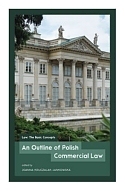An Outline of Polish Commercial Law
The Basic Concepts
This publication is intended primarily for students of courses conducted in English,
the curricula of which include topics related to the functioning of Polish entrepreneurs.
Although these topics focus primarily on domestic business transactions, foreign
transactions are also discussed. The authors hope that the book may be of interest to all
those who seek information on the private law aspects of conducting business in Poland.
An Outline of Polish Commercial Law examines issues related to how entrepreneurs function,
how they wind down activities, including for reasons of insolvency, and the legal
transactions conducted within the confines of the economic trade of so-called commercial
activities. One chapter also focuses on issues pertaining to the amicable settlement of
disputes through arbitration. It is the intention of the authors that this volume be used
as auxiliary didactic material for discussions and to assist students in preparing for
examinations.
From the Editor (Joanna Kruczalak-Jankowska) . 9
Part I Introductory Issues (Joanna Kruczalak-Jankowska) 11
Chapter 1. Concepts of business law and commercial law 13
Chapter 2. Principles of business 16
Chapter 3. Participants in business transactions 18
Part II Forms of Running Business Activities (Maciej Zejda)
. 21
Chapter 1. Introduction . 23
1.1. Outline . 23
1.2. Preliminary remarks . 23
Chapter 2. Sole proprietorship . 28
Chapter 3. Partnerships . 29
3.1. Civil law partnerships 30
3.2. Commercial Partnerships 33
3.3. Registered partnership . 36
3.4. Professional partnership 38
3.5. Limited Partnership . 39
3.6. Limited joint-stock partnership 42
Chapter 4. Companies 43
4.1. Preliminary remarks . 43
4.2. Incorporation . 48
4.3. Company bodies . 51
4.4. Liability of company body members 59
4.5. End of companies 61
Chapter 5. Raising finance 64
5.1. Sole proprietorships . 64
5.2. Partnerships 64
5.3. Companies . 65
Chapter 6. Strategic legal drafting . 68
Part III Insolvency and Restructuring Proceedings in Poland (Monika
Maśnicka) 83
Chapter 1. Preliminary remarks . 85
Chapter 2. Court and insolvency practitioners . 88
Chapter 3. Insolvency proceedings 90
3.1. Requirements to start insolvency proceedings 90
3.2. Rules on ranking claims . 91
Chapter 4. Restructuring proceedings 95
4.1. Requirements to start restructuring proceedings 95
4.2. Requirements for the approval of an arrangement and the role of the restructuring
plan 97
4.3. Available out-of-court proceedings for business restructuring . 101
Part IV Trading Contracts in Domestic and International Trade – Selected
Problems (Robert Obrzud) 103
Chapter 1. General considerations . 105
1.1. The definition of a commercial contract 105
1.2. The division of commercial contracts 106
1.3. The characteristics of commercial contracts 108
1.4. Sources of law for commercial contracts in international trade 109
1.4.1. Sources of statutory and non-statutory law 109
1.4.2. Soft law . 111
Chapter 2. Commercial contracts in the Polish legal order 113
2.1. Preliminary activities to the conclusion of a commercial contract 113
2.1.1. Letter of intent 113
2.1.2. Preliminary agreement . 114
2.1.3. Contractual models . 115
2.1.4. Means of concluding commercial contracts 118
2.1.4.1. The offer and its acceptance 118
2.1.4.2. Negotiations 120
2.1.4.3. Auction and tender 121
Chapter 3. Contracts concluded with consumers . 124
3.1. Consumer rights . 124
3.2. Off-premises and distance contracts . 127
3.3. The consumer’s right of withdrawal . 132
3.4. Contracts referring to distance financial services . 137
Chapter 4. Forms of commercial contracts . 142
4.1. Basic forms and specific legal transactions . 142
4.2. The consequences of the failure to observe the form of a legal transaction 144
Chapter 5. Securing the performance of a commercial contract . 146
5.1. General observations 146
5.2. Guarantee . 146
5.3. Blank promissory note . 149
5.4. Bank guarantee 151
Chapter 6. Selected commercial contracts 154
6.1. Commercial contracts in domestic trade. Sales contract 154
6.2. An agency agreement 156
6.3. A forwarding contract 157
6.4. Contract of carriage . 158
6.5. Storage contract . 161
6.6. Leasing contract . 162
6.7. International trade contracts . 164
6.7.1. International sale of goods . 164
6.7.2. International carriage of goods by road 168
Part V International Dispute Resolution (Kaja
Zaleska-Korziuk) 173
Chapter 1. Introduction . 175
1.1. Outline . 175
1.2. Preliminary remarks . 175
Chapter 2. International litigation . 177
2.1. Jurisdiction: Brussels I bis 181
2.2. Applicable law . 185
2.2.1. Rome I Regulation 185
2.2.2. Rome II Regulation 188
2.3. The problem of forum shopping . 190
Chapter 3. International commercial arbitration 193
3.1. The concept of arbitration . 193
3.2. Legal framework of international commercial arbitration . 195
3.2.1. Arbitration rules . 197
3.2.2. The UNCITRAL model law on international arbitration 198
3.2.3. Lex arbitri 199
3.2.4. New York Convention on the Recognition and Enforcement of Foreign Arbitral Awards .
200
3.3. Types of arbitration: ad hoc arbitration, institutional arbitration . 201
3.4. Arbitration agreement . 204
3.4.1. Submission agreement and arbitration clause 204
3.4.2. Separability of an arbitration agreement 205
3.4.3. Competence-competence doctrine . 206
3.4.4. Validity of arbitration agreements 207
3.4.4.1. Formal validity . 207
3.4.4.2. Arbitrability . 210
3.4.5. Strategic contract drafting – arbitration agreement . 211
3.4.5.1. Model arbitration agreements . 212
3.4.5.2. Identification of legal relationship . 213
3.4.5.3. Adoption of arbitration as a method of dispute resolution . 214
3.4.5.4. Selection of institutional or ad hoc arbitration . 214
3.4.5.6. Provision on finality and bindingness . 216
3.4.6. Pathological arbitration clauses 216
Chapter 4. Alternative dispute resolution 232
4.1. Negotiation 233
4.2. Mediation . 233
4.2.1. Concept of mediation 233
4.2.2. Development of mediation in Poland. Note 236
4.3. Other types of ADR 240
4.3.1. Conciliation 240
4.3.2. Mini-trial 241
4.3.3. Early neutral evaluation . 241
4.3.4. Dispute review board 241
4.3.5. Baseball arbitration . 242
4.3.6. Med-Arb and Arb-Med . 242
4.4. Multi-tiered dispute resolution clauses . 243
4.5. ADR – pros and cons. Assignment topic 244
Selected Further Reading 245
246 pages, Paperback


